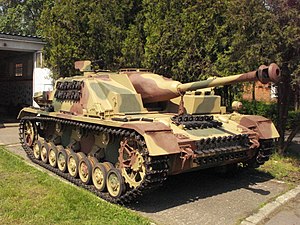Sturmgeschütz IV
| Sturmgeschütz IV | |
|---|---|
 | |
| Type | Assault gun |
| Place of origin | |
| Service history | |
| Used by | Nazi Germany |
| Wars | World War II |
| Production history | |
| Manufacturer | Krupp-Grusonwerk AG |
| Produced | late 1943 - 1945 |
| No. built | 1,108 +31 conversions |
| Specifications | |
| Mass | 23 tonnes (50,705 lbs) |
| Length | 6.70 m (22 ft) |
| Width | 2.95 m (9.67 ft) |
| Height | 2.20 m (7.21 ft) |
| Crew | 4 (Commander, Gunner, Loader, Driver) |
| Armor | 10 - 80 mm (.39 - 3.14 in) |
Main armament | 1x 7.5 cm StuK 40 L/48 63 rounds |
Secondary armament | 1x 7.92 mm Maschinengewehr 34 600 rounds |
| Engine | V12-cylinder Maybach HL 120 TRM 300 PS (296 hp, 220.6 kW) |
| Transmission | ZF SSG 76 Aphon |
| Suspension | leaf spring |
| Ground clearance | 40.0 cm (15.7 in) |
| Fuel capacity | 430 L or 110 gal[clarification needed] |
Operational range | 210 km (130 mi) |
| Maximum speed | 40 km/h (25 mph) |
The Sturmgeschütz IV (StuG IV) (Sd.Kfz. 167), was a German assault gun of the Second World War.
Development

The Sturmgeschütz IV resulted from Krupp's effort to supply an assault gun. As Krupp did not build Panzerkampfwagen IIIs, they used the Panzerkampfwagen IV chassis in combination with a slightly modified Sturmgeschütz III superstructure.
- Initial Project The first known proposal for a Sturmgeschütz on the Panzer IV chassis is in Krupp drawing number W1468 dated February 1943. This initial drawing unitized the outdated Sturmgeschütz Ausf. F superstructure on a Panzer IV chassis 9. This proposal had a sloped front superstructure with a combat weight of 28.26 tons. Krupp abandoned it in February 1943 because it was too heavy. Plans for the StuG IV were halted.
- Another Project During the Fuhrer Conference of August 19-22, 1943, after the battle of Kursk, Hitler had seen reports of the StuG III performing superior to the Panzer IV within certain restraints of how they were deployed. Convinced that a tank-hunter version would be superior to the tank version, Hitler planned to switch Panzer IV production to "Panzerjager IV" production as soon as possible. It was to mount the same 7.5cm L70 used for the Panther. Another manufacturer, Vomag built a prototype Panzerjager IV with 7.5cm L/48 gun and demonstrated it on October 20, 1943. It was later re-designated as Jagdpanzer IV Ausf. F. As the Jagdpanzer IV was already being produced by Vomag, the StuG IV may not have materialized, had it not been for the major disruption of StuG III production, and the scarce supply of the 7.5cm L/70 gun designated for the Jagdpanzer IV.
- Restart of the StuG IV In November 1943, Alkett, a major StuG III manufacturer, was bombed. Alkett produced 255 StuG III in October 1943, but in December fell to just 24 vehicles. On December 6-7, 1943, at a conference with Hitler, he welcomed the suggestion of taking the StuG III superstructure and mounting it on a Panzer IV chassis. The StuG IV could be more quickly manufactured than the Jagdpanzer IV at the time. This re-started the Sturmgeschütz IV project. This time, the superstructure of the StuG III Ausf. G was mounted on a Panzer IV chassis 7, with a box compartment for the driver added. Combat weight was 23000kgs, lighter than the 23900kg for the StuG III Ausf. G. On Dec. 16-17, 1943, Hitler was shown the StuG IV, and approved it. To make up for the large deficit in StuG III production, StuG IV production received full support.
From December 1943 to May 1945, Krupp built 1,108 StuG IVs and converted an additional 31 from battle-damaged Panzer IV hulls. While the number is smaller than the 9000+ StuG III, the StuG IV supplemented and fought along with StuG III during 1944-45, when they were most needed.
The StuG IV became known as an effective tank killer, especially on the Eastern Front.
It had a four-man crew, and was issued mainly to infantry divisions.
- Commander in hull left rear
- Gunner in hull left center
- Loader in hull right rear
- Driver in hull left front
Surviving vehicles
There are presently two surviving examples of the StuG IV, both in Poland. One vehicle held by the Muzeum im. Orla Bialego is a makeshift restoration using a StuG IV hull and various parts from Stug III:s and Pz IV:s. The other StuG IV, held by the Museum of Armoured Weapon in Poznań, is complete and (as of August 2009) in running condition[1].
External links
- StuG IV restoration homepage (Polish)
- AFV Database - Dimensions
- Panzer World
- OnWar
- Sturmgeschütz III / IV at Achtung Panzer!
- Surviving Panzer IV variants - A PDF file presenting the Panzer IV variants (Jagdpanzer IV, Hummel, Nashorn, Brummbär, StuG IV, Flakpanzer tanks and prototypes based on Pz IV) still existing in the world.

